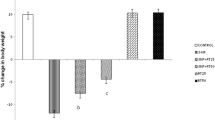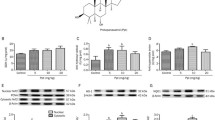Abstract
L-theanine is unique amino acid which readily crosses blood brain barrier and possesses neuroprotective potential against neurodegenerative disorders including Huntington disease (HD). HD is characterized by selective loss of GABAergic medium spiny neurons. 3-nitropropionic acid (3-NP) induces a spectrum of HD-like neuropathology in rat striatum and widely used as experimental tool to study HD. Therefore, the present study was intended to investigate the effect of L-theanine against 3-NP-induced striatal toxicity and to explore its possible mechanism. Rats were administered with 3-NP for 21 days. L-theanine was given once a day, 1 h prior to 3-NP treatment for 21 days and L-NAME (10 mg/kg, i.p.), NO inhibitor and L-arginine (50 mg/kg; i.p.), NO precursor were administered 1 h prior to L-theanine treatment. Body weight and behavioral observation were made on weekly basis. On the 22nd day, animals were sacrificed, and the striatum was isolated for biochemical (LPO, GSH, and nitrite), pro-inflammatory cytokines and neurochemical analysis. 3-NP treatment significantly altered body weight, locomotor activity, motor coordination, mitochondrial complex-II activity, oxidative defense, pro-inflammatory mediators, and striatal neurotransmitters level. L-theanine pre-treatment (25 and 50 mg/kg/day, p.o.) significantly prevented these alterations. In addition, concurrent treatment of L-NAME with L-theanine (25 mg/kg/day, p.o.) significantly enhanced protective effect of L-theanine (25 mg/kg/day, p.o.) whereas concurrent treatment of L-arginine with L-theanine (50 mg/kg/day, p.o.) significantly ameliorated the protective effect of L-theanine (50 mg/kg/day, p.o.). The neuroprotective potential of L-theanine involves inhibition of detrimental nitric oxide production and prevention of neurotransmitters alteration in the striatum.










Similar content being viewed by others
Abbreviations
- 3-NP:
-
3-Nitropropionic acid
- 5-HIAA:
-
5-Hydroxy 3-Indole acetic acid
- DOPAC:
-
3,4-dihydroxyphenylacetic acid
- HVA:
-
Homovanillic Acid
- HD:
-
Huntington’s disease
- IL:
-
Inter leukin
- MSNs:
-
Medium spiny neurons
- NMDA:
-
N-methyl d-aspartate
- NMDAR:
-
N-methyl D-aspartate receptor
- ROS:
-
Reactive oxygen species
- SDH:
-
Succinate dehydrogenase
References
Kakuda T (2011) Neuroprotective effects of theanine and its preventive effects on cognitive dysfunction. Pharmacol Res 64(2):162–168
Brouillet E, Jacquard C, Bizat N, Blum D (2005) 3‐Nitropropionic acid: a mitochondrial toxin to uncover physiopathological mechanisms underlying striatal degeneration in Huntington’s disease. J Neurochem 95(6):1521–1540
Brouillet E (2014) The 3‐NP model of striatal neurodegeneration. Curr Protoc Neurosci 9(48):1–9
Khan A, Jamwal S, Bijjem K, Prakash A, Kumar P (2015) Neuroprotective effect of hemeoxygenase-1/glycogen synthase kinase-3β modulators in 3-nitropropionic acid-induced neurotoxicity in rats. Neuroscience 287:66–77
Jamwal S, Kumar P (2016) Spermidine ameliorates 3-nitropropionic acid (3-NP)-induced striatal toxicity: possible role of oxidative stress, neuroinflammation, and neurotransmitters. Physiol Behav 155:180–187
Jamwal S, Singh S, Kaur N, Kumar P (2015) Protective effect of spermidine against excitotoxic neuronal death induced by quinolinic acid in rats: possible neurotransmitters and neuroinflammatory mechanism. Neurotox Res 28(2):171–184
Kumar P, Kalonia H, Kumar A (2011) Role of LOX/COX pathways in 3‐nitropropionic acid‐induced Huntington’s disease‐like symptoms in rats: protective effect of licofelone. Br J Pharmacol 164(2b):644–654
Chen JY, Wang EA, Cepeda C, Levine MS (2013) Dopamine imbalance in Huntington’s disease: a mechanism for the lack of behavioral flexibility. Front Neurosci. doi:10.3389/fnins.2013.00114
Milnerwood AJ, Gladding CM, Pouladi MA et al (2010) Early increase in extrasynaptic NMDA receptor signaling and expression contributes to phenotype onset in Huntington’s disease mice. Neuron 65(2):178–190
Navailles S, De Deurwaerdère P (2011) Presynaptic control of serotonin on striatal dopamine function. Psychopharmacology 213(2–3):213–242
Kumar P, Kumar P, Khan A, Deshmukh R, Lal Sharma P (2014) Role of neurosteroids in experimental 3-nitropropionic acid induced neurotoxicity in rats. Eur J Pharmacol 723:38–45
Tunez I, Tasset I, Pérez-De La Cruz V, Santamaría A (2010) 3-Nitropropionic acid as a tool to study the mechanisms involved in Huntington’s disease: past, present and future. Molecules 15(2):878–916
Wills E (1966) Mechanisms of lipid peroxide formation in animal tissues. Biochem J 99:667–676
Green LC, Wagner DA, Glogowski J, Skipper PL, Wishnok JS, Tannenbaum SR (1982) Analysis of nitrate, nitrite, and [15N] nitrate in biological fluids. Anal Biochem 126(1):131–138
Ellman GL (1959) Tissue sulfhydryl groups. Arch Biochem Biophys 82(1):70–77
Lowry O, Rosebrough N, Farr A, Randall R (1951) Protein measurement with the Folin phenol reagent. J Biol Chem 193:265–275
Donzanti BA, Yamamoto BK (1988) An improved and rapid HPLC-EC method for the isocratic separation of amino acid neurotransmitters from brain tissue and microdialysis perfusates. Life Sci 43(11):913–922
Akula KK, Kaur M, Bishnoi M, Kulkarni SK (2008) Development and validation of an RP‐HPLC method for the estimation of adenosine and related purines in brain tissues of rats. J Sep Sci 31(18):3139–3147
Singh S, Jamwal S, Kumar P (2015) Piperine enhances the protective effect of curcumin against 3-NP induced neurotoxicity: possible neurotransmitters modulation mechanism. Neurochem Res 40(8):1758–1766
Thangarajan S, Deivasigamani A, Natarajan SS, Krishnan P, Mohanan SK (2014) Neuroprotective activity of L-theanine on 3-nitropropionic acid-induced neurotoxicity in rat striatum. Int J Neurosci 124(9):673–84
Kim GW, Copin J-C, Kawase M et al (2000) Excitotoxicity is required for induction of oxidative stress and apoptosis in mouse striatum by the mitochondrial toxin, 3-nitropropionic acid. J Cereb Blood Flow Metab 20(1):119–129
Kakuda T, Nozawa A, Sugimoto A, Niino H (2002) Inhibition by theanine of binding of [3H] AMPA,[3H] kainate, and [3H] MDL 105,519 to glutamate receptors. Biosci Biotechnol Biochem 66(12):2683–2686
Blum D, Gall D, Galas MC, d’Alcantara P, Bantubungi K, Schiffmann SN (2002) The adenosine A1 receptor agonist adenosine amine congener exerts a neuroprotective effect against the development of striatal lesions and motor impairments in the 3-nitropropionic acid model of neurotoxicity. J Neurosci 22:9122–9133
Blum D, Hourez R, Galas MC, Popoli P, Schiffmann SN (2003) Adenosine receptors in Huntington’s disease. Lancet Neurol 2:366–374
Kaku T, Hada J, Hayashi Y (1994) Endogenous adenosine exerts inhibitory effects upon the development of spreading depression and glutamate release induced by microdialysis with high K+ in rat hippocampus. Brain Res 658(1):39–48
Latini S, Pedata F (2001) Adenosine in the central nervous system: release mechanisms and extracellular concentrations. J Neurochem 79(3):463–484
Kumar P, Kalonia H, Kumar A (2012) Possible GABAergic mechanism in the neuroprotective effect of gabapentin and lamotrigine against 3-nitropropionic acid induced neurotoxicity. Eur J Pharmacol 674(2):265–274
Kakuda T, Yanase H, Utsunomiya K, Nozawa A, Unno T, Kataoka K (2000) Protective effect of γ-glutamylethylamide (theanine) on ischemic delayed neuronal death in gerbils. Neurosci Lett 289(3):189–192
Kiramura R, Murata T (1986) Effect of theanine on norepinephrine and serotonin levels in rat brain. Chem Pharm Bull 34(7):3053–3057
Yokogoshi H, Kobayashi M, Mochizuki M, Terashima T (1998) Effect of theanine, r-glutamylethylamide, on brain monoamines and striatal dopamine release in conscious rats. Neurochem Res 23(5):667–673
Di X, Yan J, Zhao Y, Zhang J, Shi Z, Chang Y, Zhao B (2010) L-theanine protects the APP (Swedish mutation) transgenic SH-SY5Y cell against glutamate-induced excitotoxicity via inhibition of the NMDA receptor pathway. Neuroscience 168(3):778–786
Yang H, Li W, Yu H, Yuan R, Yang Y, Pung K, Xue L (2013) Physiological effects of l-theanine on Drosophila melanogaster. Molecules 18(11):13175–13187
Sumathi T, Asha D, Nagarajan G, Sreenivas A, Nivedha R (2016) L-theanine alleviates the neuropathological changes induced by PCB (Aroclor 1254) via inhibiting upregulation of inflammatory cytokines and oxidative stress in rat brain. Environ Toxicol Pharmacol 42:99–117
Sumathi T, Shobana C, Thangarajeswari M, Usha R (2015) Protective effect of L-theanine against aluminium induced neurotoxicity in cerebral cortex, hippocampus and cerebellum of rat brain–histopathological, and biochemical approach. Drug Chem Toxicol 38(1):22–31
Acknowledgments
Authors are thankful to the Science and Engineering Board (SERB), Department of Science and Technology, Govt. of India, New Delhi, for providing financial assistance under Fast Track Scheme (DST-SERB-FTYS) to Dr. Puneet Kumar. The Junior Research Fellowship to Mr. Sumit Jamwal is also highly acknowledged.
Author information
Authors and Affiliations
Corresponding author
Ethics declarations
The experimental protocol was reviewed and approved by the Institutional Animal Ethics Committee (ISFCP/IAEC/M5/2012/P39), and experiments were conducted in compliance with the guidelines of the Indian National Science Academy (INSA) for the use and care of experimental animals.
Conflict of Interest
The authors declare that they have no conflict of interests.
Rights and permissions
About this article
Cite this article
Jamwal, S., Kumar, P. L-theanine, a Component of Green Tea Prevents 3-Nitropropionic Acid (3-NP)-Induced Striatal Toxicity by Modulating Nitric Oxide Pathway. Mol Neurobiol 54, 2327–2337 (2017). https://doi.org/10.1007/s12035-016-9822-5
Received:
Accepted:
Published:
Issue Date:
DOI: https://doi.org/10.1007/s12035-016-9822-5




